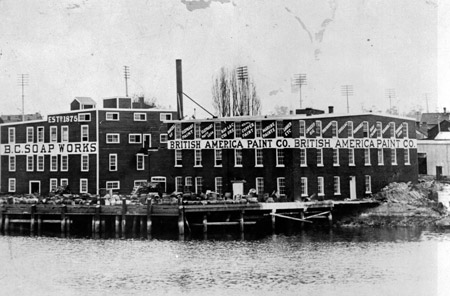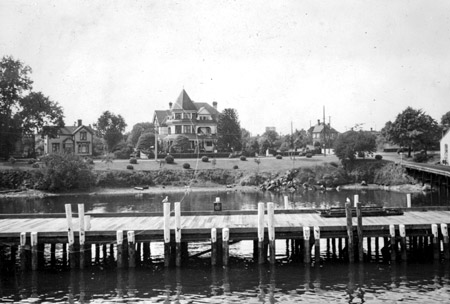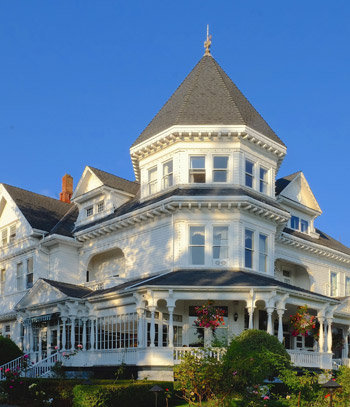Oct
7
The Pendray Family: Part II
Oct 2014
By Ted Ross
See also The Pendray Family: Part I
Vancouver's daily The News-Herald, May 18, 1950 in a feature on the Pendrays, related, "In 1899 Mr. Pendray bought the British Columbia branch of Canada Paint Company… the firm name British American Paint Company was started, from which evolved the household name of Bapco."
 |
| Image F-00090 courtesy of the Royal BC Museum, BC Archives |
The January 20, 1901 Daily Colonist reported on the soap and paint works, "Mr. Pendray, who operates this paint factory, as well as the soap works adjoining, has aimed to make his establishments as complete as possible...," going on to tell of the print shop, box plant and metal can shop in the factory that provided the containers needed to get his products to market. Photographs with the article show many of the dozens of employees who worked there, as well as the two plants' exteriors.
In the November 1, 1999 The Islander, Danda Humphreys reported, "Pendray's soap works at Humboldt and Douglas backed onto James Bay, contributing to the stench that sickened local residents and assailed the nostrils..." but, more positively she added, "Twelve kinds of ordinary household soap complemented by toilet soaps of every scent and colour (were made)."
In 1906 William sold the land the factories sat on to the CPR. The Empress Hotel would rise on the newly-filled mudflats, with its north entrance eventually on Humboldt Street, site of William's works. A new factory was constructed by Moore & Whittington of Fernwood on William's property on Laurel Point, bringing industry to that scenic location.
William's eldest son, Ernest C., born 1878, worked at the Laurel Point location, involved in management. On November 24, 1908, going for lunch, he climbed up to sit beside the driver of a loaded horse-drawn freight wagon that would pass his home two blocks away on Belleville. There he would climb off. As they arrived at the house an approaching automobile startled the horse, causing it to shy and rear straight up at the same time, breaking one of the wagon's shafts. Ernest jumped from the wagon to avoid the horse's hooves, the driver imploring him to stay on. Then the other shaft broke. Ernest fell under the wagon, and one of its wheels crushed his head, killing him instantly. The Daily Colonist November 26, 1908 reported, "(He) fell face downward upon the street right under the rear wheel of the truck, which passed over his head and shoulder....The load weighed about 2700 pounds."
It was a huge blow to William and Amelia and the three surviving brothers. But they prevailed. The soap works and Bapco paint continued to grow and succeed in their Laurel Point location. William was looking to purchase the White Swan Soap Business, but tragedy intervened.
The September 18, 1913 Victoria Daily Colonist reported, "Through the collapse of the feed pipe of the tank forming a part of the new fire protection service... Mr. William Joseph Pendray, president of the company,... was instantly killed yesterday morning shortly after 9 o'clock." Struck on the head by the falling pipe, William's skull was crushed. He was 68 years old.
Management of the company fell to his second son, J. Carl (1879-1961). Under his stewardship the soap company was sold to Royal Crown Soaps on October 21, 1913. The new owners made soap until they closed and moved to the mainland in 1926.
Herbert, the third son (1883-1956), became the vice-president of the paint company. Married, he had no children. He and his wife were active in the Metropolitan United Church, leaving a bequest to the church, which led to the construction of Pendray Hall.
Youngest son Roy (1891-1932) managed the prairie operations from Calgary. Pneumonia took him at the age of 41 in 1932. His widow and four daughters were left. They moved back to Victoria after Roy's death.
Carl managed Bapco until his retirement. He served as mayor of Victoria from 1924-28. Upon retirement, in 1948, his son Allan became president of the company. On January 1, 1966 Canadian Industries Limited purchased Bapco. In 1973 the company moved operations to the mainland.
 |
| Image I-20602 courtesy of the Royal BC Museum, BC Archives |
Laurel Point then became the site of a luxury hotel and condominiums, redeeming this beautiful seaside location from the scars of industry.
Amelia lived out her years in the house at 309 Bellville. The tragic loss of her youngest son Roy in 1932 dealt yet another blow to this mother. Still she grew old gracefully, tending her garden, visiting friends, working with her church and charitable organizations and invariably with her family. She passed away, a great grandmother, at age 87 in May of 1937.
In 1939 the mansion was purchased by the Sisters Notre Dame des Anges, a Roman Catholic Missionary Sisterhood. This sisterhood was founded in Montreal in 1658 by Sainte Marguerite Bourgeois and had been working in China for many years. In 1940 they opened the building as a hostel for Chinese women and called it Loretto Hall.
 |
| Photo by Bob Tuomi |
The house became the Captain's Palace, an inn and restaurant, operated by Florence and Bill Prior in 1970. In 1980 the Priors had a Pendray family reunion at which the topiary garden was replanted, fifty-seven years after William's death. In their term the Priors extensively restored the house, uncovering all the coloured glass and painstakingly exposing the painted-over frescoes on room ceilings. They returned the dwelling to its original condition.
Today the residence is the Gatsby Mansion, main house of the Huntington Hotel's Bellville Park Resort.
Bibliography
Victoria Heritage Foundation, Heritage Register James Bay, "309 Bellville St.", 2013; Victoria Historical Society Publication, Autumn 2006; Victoria Daily Colonist, 1908-11-26; Victoria Daily Colonist, 1913-09-28; Wikipedia, "John Carl Pendray", 2014; The Islander, "The Man Who Cleaned Up", Danda Humphreys, 1999; Victoria Daily Colonist, "William J. Pendray", 1948-12-05; The News-Herald, Vancouver, "Feature Page on Pendray Family", May 18, 1950; The Islander, "The Pendray Family and the Palace", 1980; The Islander, "Topiary Gardens Replanted", James K. Nesbitt, June 22, 1980; Victoria & its Remarkable Buildings, "James Bay-Pendray House", Robin Ward, Harbour Publishing, 1996; Camas Chronicles of James Bay, "The Pendray Story", Ruth Judson, Camas Historical Group, 1978.
I am truly grateful to the Victoria Public Library downtown branch and their local history room with its books and clipping files on local topics going back for many years. I am also grateful to the Victoria City Archives and their ever-so-helpful staff, who put the best photos and clippings in my hands. TR
